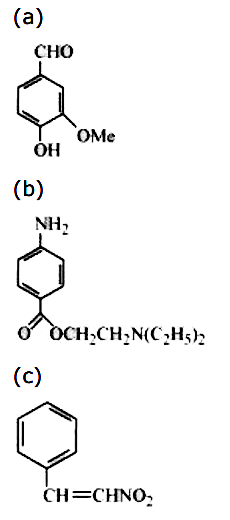Ozonolysis of an organic compound (A) produces acetone and acetaldehyde. Identify 'A' from the following compounds
2− Methyl −1− butene
1− Pentene
2− Pentene
2− Methyl −2− butene
The correct Answer is:D
To solve the problem of identifying the organic compound (A) that undergoes ozonolysis to produce acetone and acetaldehyde, we can follow these steps:
1. Understanding Ozonolysis: Ozonolysis is a reaction where alkenes react with ozone (O3) to form carbonyl compounds (aldehydes and ketones). The products depend on the structure of the alkene.
2. Identifying the Products: The products given are acetone (CH3COCH3) and acetaldehyde (CH3CHO). Acetone is a ketone and acetaldehyde is an aldehyde.
3. Analyzing the Carbon Count:
- Acetone has 3 carbons.
- Acetaldehyde has 2 carbons.
- Therefore, the total number of carbons from the products is 5. The compound (A) must also have 5 carbons.
4. Considering Possible Structures: We need to evaluate the possible structures of alkenes that can yield these products upon ozonolysis. The options provided include:
- 2-methyl-1-butene
- 1-pentene
- 2-pentene
- 2-methyl-2-butene
5. Evaluating Each Compound:
- 2-methyl-1-butene:
- Structure: CH2=C(CH3)CH2CH3
- Ozonolysis would not yield both products; it would yield different aldehydes.
- 1-pentene:
- Structure: CH2=CH(CH2)3CH3
- Ozonolysis would yield products that do not include acetone.
- 2-pentene:
- Structure: CH3-CH=CH-CH3
- Ozonolysis would yield products that do not include acetone.
- 2-methyl-2-butene:
- Structure: CH3-C(CH3)=C(CH3)-CH3
- Ozonolysis of this compound would yield acetone and acetaldehyde.
6. Conclusion: Based on the analysis, the correct compound (A) that produces acetone and acetaldehyde upon ozonolysis is 2-methyl-2-butene.
Final Answer:
The organic compound (A) is 2-methyl-2-butene.
- Acetone has 3 carbons.
- Acetaldehyde has 2 carbons.
- Therefore, the total number of carbons from the products is 5. The compound (A) must also have 5 carbons.
- 2-methyl-1-butene
- 1-pentene
- 2-pentene
- 2-methyl-2-butene
- 2-methyl-1-butene:
- Structure: CH2=C(CH3)CH2CH3
- Ozonolysis would not yield both products; it would yield different aldehydes.
- 1-pentene:
- Structure: CH2=CH(CH2)3CH3
- Ozonolysis would yield products that do not include acetone.
- 2-pentene:
- Structure: CH3-CH=CH-CH3
- Ozonolysis would yield products that do not include acetone.
- 2-methyl-2-butene:
- Structure: CH3-C(CH3)=C(CH3)-CH3
- Ozonolysis of this compound would yield acetone and acetaldehyde.
The organic compound (A) is 2-methyl-2-butene.
Topper's Solved these Questions
- ALKENE, ALKANE & ALKYNE BOOK - ALLENCHAPTER - ALKENE, ALKANE & ALKYNE EXERCISE - EXERCISE-5(B)
66 Videos
- ALKENE, ALKANE & ALKYNE BOOK - ALLENCHAPTER - ALKENE, ALKANE & ALKYNE EXERCISE - EXERCISE-4[A]
50 Videos
- ALKENE, ALKANE & ALKYNE BOOK - ALLENCHAPTER - ALKENE, ALKANE & ALKYNE EXERCISE - EXERCISE-4(B)
10 Videos
- AIIMS 2019BOOK - ALLENCHAPTER - AIIMS 2019EXERCISE - CHEMISTRY
40 Videos
- ALKYL AND ARYL HALIDEBOOK - ALLENCHAPTER - ALKYL AND ARYL HALIDEEXERCISE - EXERCISE-05 (B)
35 Videos
Similar Questions
Knowledge Check
Ozonolysis of an organic compound A produces acetone and propionaldehyde in equimolar mixture. Identify A from the following compounds.
A2-methyl pent-l-eneBpent-1-eneCpent-2-eneD2-methyl pent-2-eneOzonolysis of the following compound will produce ,
 is : ACH3−O||C−O||C−H,H−O||C−O||C−HBCH3−O||C−O||C−CH3,H−O||C−O||C−HCCH3−O||C−O||C−CH3,CH3−O||C−O||C−HDCH3−O||C−H,H−O||C−O||C−H
is : ACH3−O||C−O||C−H,H−O||C−O||C−HBCH3−O||C−O||C−CH3,H−O||C−O||C−HCCH3−O||C−O||C−CH3,CH3−O||C−O||C−HDCH3−O||C−H,H−O||C−O||C−H
Identify the functional groups in the following compounds

View SolutionHow will you convert acetaldehyde into the following compounds ?
Butan-2-one
View SolutionHow will you convert acetaldehyde into the following compounds ?
But-2-enal
View SolutionHow will you convert acetaldehyde into the following compounds ?
But-2-enal
View SolutionHow will you convert acetaldehyde into the following compounds ?
But-2-enal
View SolutionHow will you convert acetaldehyde into the following compounds ?
Butan-1-ol
View Solution


